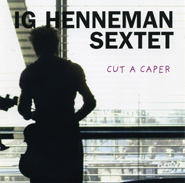Ig
Henneman Sextet
Cut A Caper
(Wig)
"Cut
a caper", with "caper" as "the bud from the plant":
this was, at first, what I thought to be the meaning of the title of Ig
Henneman's new album. And, in a way, this was not terribly out of character
anyway, since I remember this fine musician and composer from Holland to
be a lover of Mediterranean-flavoured things (and wasn't Sicilianina the
name of a composition of hers that I happened to see performed on a stage
in Rome, about ten years ago?). I prudently consulted my English dictionary,
which revealed to me a previously unknown meaning of "Cut a caper",
i.e., "make a playful, skipping movement".
Ig
Henneman's music could be referred to as austere, and it's obviously conceived
with a strong sense of economy of means, both in conceptualizing and execution.
But it's not too difficult, at times, to locate a joyous element, strongly
linked to the realm of dance, in those independent melodic lines running
parallel, in some of those peculiar mixes of Baroque and Minimalism that
on the surface are so paradoxically sounding. Once again, my dictionary
revealed to me that the title of the first track here, Moot, actually meant "a
regular gathering of people having a common interest".
I
really don't know how regular the gatherings of this Sextet are (the laws
of finance being quite independent from those of aesthetics), but here
things work as a charm. As per her usual featured on viola (and also, here,
on composition), Ig Henneman is ably assisted by Ab Baars, on tenor sax,
clarinet, and shakuhachi; Axel Dörner, on trumpet; Lori Freedman, on clarinet,
and bass clarinet; Wilbert De Jode, on double bass; Marilyn Lerner, on
piano. (I assume Bars and Dörner to be quite well-known. When it comes
to the others, I'll just mention the Queen Mab Trio, featuring Freedman,
Lerner, and Henneman; and the fine solo album by De Joode, Olo.)
Thanks
to an excellent recorded sound, it's very easy to appreciate the players'
contribution, with a strong technical side and a lot of fine inventions
when it comes to timbre. Having admitted my weakness for De Joode's bass
work - but every player here performs admirably - I have to say I was very
favourably impressed by the piano solos, which reminded me of many things,
and of none, at the same time. It goes without saying that a silent room
and one's undivided attention are a prerequisite in order to appreciate
an album like this, where the music is not really "difficult",
but definitely not intended
"for everybody".
The
viola opens Moot, like a call to the gathering. Then trumpet and clarinets
appear, then it's piano and double bass, a little theme gets harmonized,
so becoming quite "orchestral". There's a fine piano solo, mostly
played on the bottom portion of the keyboard with the resonance pedal -
strange to see the solo arriving at what sounds like a lullaby performed
by a musical box. Nice ensemble close.
Recorded
live, Light Verse has a strange "inhaling though the nose" sound
as it chosen attack signal (a dangerous strategy: a fan suffering from
sinusitis sitting in the first row could easily make a train-wreck of these
carefully organized arrangements). Fine theme, a good trumpet solo
"noisy-ambient", a fine clarinet solo by Baars, a rare viola solo,
almost sounding like a banjo (!).
Double
bass played arco, bass clarinet, and tenor sax - all "hushed" -
give a "Misterioso" quality to Brain And Body (with a nod to
Body And Soul?). The composition gets progressively faster, with a solo
on tenor sax sporting an interesting arch, from bass register to screaming
overtones; there's a fine, and quite "orchestral", "almost-Dixieland"
backing.
Rivulet
is very quiet, with a minimal palette giving the composition an
"eastern" mood: just listen to those harmonics, the double bass
sounding almost like a koto, the shakuachi, the prepared piano.
Narration
has a fine theme performed using just a few notes played staccato (a compositional
technique that's dear to Henneman). Ab Baars plays a
"free" solo on clarinet, there's an excellent mix of strings and
trumpet, then a fine solo moment by De Joode.
I
have to confess that, at first, I was not particularly impressed by the
second part of this CD. Until, that is, I decided to listen to it first
(the album is not "too long", but this music requires quite a
bit of attention). I think I can say that that those tracks starting with
track six all share a different writing quality, where lines are more long
and involved, which makes for a more varied album.
Toe
And Heel features a longer melodic stream. There's a fine crescendo, also
a beautiful interlude for viola and double bass.
Recorded
live, Fervid sounds at times more than a bit Mingus-like, and features
a piano solo - quite "giant" in timbre - which unexpectedly ends
with a trill at the upper end of the keyboard.
Cut
A Caper has a long, hushed, start, then it's time for a "dancing"
theme - almost a Minimalist Minuet - and a complex development for bass clarinet,
double bass, and tenor sax.
As
per its title, Precarious Gait walks precariously, with single, isolated
sounds, and a fine use of shakuachi.
The
closing track, A Far Cry, presents a fine melody, and an intelligent economy
of means.
Beppe Colli
© Beppe Colli 2011
CloudsandClocks.net
| Sept. 29, 2011











